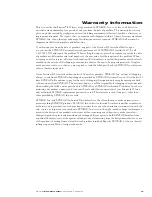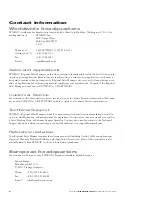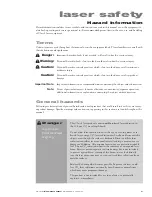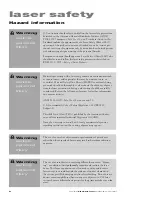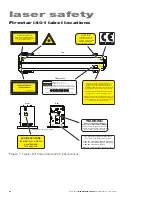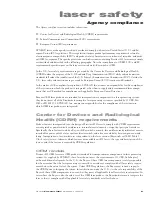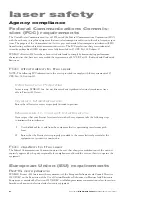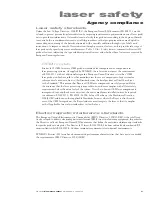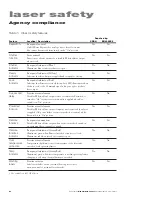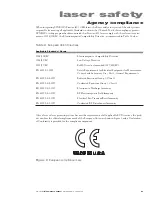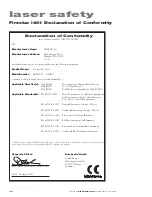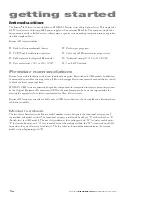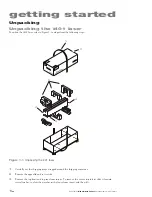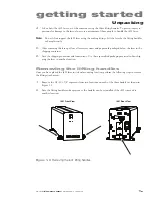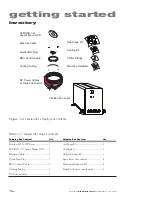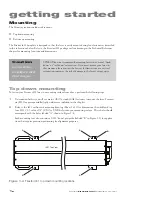
laser safety
3
Synrad
Firestar i401
operator’s manual
Hazard information
Firestar
®
i401 lasers should be installed and operated in manufacturing or laboratory facilities by trained
personnel only. Due to the considerable risks and hazards associated with the installation and operational
use of any equipment incorporating a laser, the operator must follow product warning labels and instruc-
tions to the user regarding laser safety.
To prevent exposure to direct or scattered laser radiation, follow all safety precautions specified throughout
this manual and exercise safe operating practices per ANSI Z136.1-2007 at all times when actively lasing.
Always wear safety glasses or protective goggles with side shields to reduce the risk of damage to the eyes
when operating the laser.
A CO
2
laser is an intense heat source and will ignite most materials under the proper conditions. Never
operate the laser in the presence of flammable or explosive materials, gases, liquids, or vapors.
The use of controls or adjustments or performance of procedures other than those specified herein may re-
sult in exposure to hazardous
invisible laser radiation, damage to, or malfunction of the laser. Severe burns
will result from exposure to the laser beam.
Safe operation of the laser requires the use of an external beam block to safely block the beam from travel-
ing beyond the desired work area. Do not place your body or any combustible object in the path of the
laser beam. Use a water-cooled beam dump or power meter, or similar non-scattering, noncombustible
material as the beam block. Never use organic material or metals as the beam blocker; organic materials, in
general, are apt to combust or melt and metals act as specular reflectors which may create a serious hazard
outside the immediate work area.
Other hazards
The following hazards are typical for this product family when incorporated for intended use: (A) risk of
injury when lifting or moving the unit; (B) risk of exposure to hazardous laser energy through unauthorized
removal of access panels, doors, or protective barriers; (C) risk of exposure to hazardous laser energy and
injury due to failure of personnel to use proper eye protection and/or failure to adhere to applicable laser
safety procedures; (D) risk of exposure to hazardous or lethal voltages through unauthorized removal of
covers, doors, or access panels; (E) generation of hazardous air contaminants that may be noxious, toxic, or
even fatal.
Disposal
This product contains components that are considered hazardous industrial waste. If a situation occurs
where the laser is rendered non-functional and cannot be repaired, it may be returned to SYNRAD, Inc.
who, for a fee, will ensure adequate disassembly, recycling and/or disposal of the product.
Additional laser safety information
The SYNRAD web site (http://www.synrad.com/LaserFacts/lasersafety.html) contains an online laser
safety handbook that provides information on (1) Laser Safety Standards for OEM’s/System Integrators,
(2) Laser Safety Standards for End Users, (3) References and Sources, and (4) Assistance with Require-
ments.
In addition, the Occupational Safety and Health Administration (OSHA) provides an online Technical
Manual (located at http://www.osha.gov/dts/osta/otm/otm_iii/otm_iii_6.html). Section III, Chapter 6 and
Appendix III are good resources for laser safety information.
Another excellent laser safety resource is the Laser Institute of America (LIA). Their comprehensive web
site is located at http://www.laserinstitute.org.











